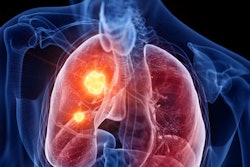Measuring visceral adipose tissue (VAT) volume on unenhanced chest CT may be a useful prognostic factor in patients with esophageal cancer, according to study results presented December 5 at the RSNA meeting.
"[We found that] VAT volume and CT attenuation obtained by AI were significantly associated with shorter survival in patients with esophageal cancer," presenter Akinori Hata, MD, PhD, of Osaka University School of Medicine in Japan told session attendees.
Chest CT offers useful information on conditions in the body, including the state of an individual's adipose tissue and muscle, Hata noted. Studies have linked the presence of fatty tissue and loss of muscle mass (i.e., sarcopenia) to poor prognosis for a variety of diseases.
Hata and colleagues developed an AI segmentation model for adipose tissue and muscle volume using data taken from chest CTs in a cohort of lung cancer patients. The model segments and quantifies subcutaneous adiopose tissue (SAT), VAT, and paravertebral muscle. The group explored the model's efficacy for quantifying adipose tissue and muscle and any links to mortality in esophageal cancer patients.
The team conducted a study that included 464 patients who underwent baseline CT scans for esophageal cancer (both with contrast and without contrast) between 2011 and 2015. They obtained quantitative values for SAT volume, VAT volume, VAT/SAT ratio, intermuscular adipose tissue (IMAT) volume, muscle CT attenuation, and percentage of adipose tissue (range, -170 HU to -40 HU). Three radiologists manually segmented adipose tissue and paravertebral muscle in 15 patients; the investigators used the Dice score to compare the radiologists' manual segmentations and those performed by the AI model and evaluated any associations between AI segmentation and overall survival in five years.
The AI model showed good performance compared with the radiologist readers:
| Performance of AI model compared with radiologists for quantifying body tissue in patients with esophageal cancer | |
|---|---|
| Type of tissue | Dice score (with 1 as reference) |
| SAT | |
| Reader 1 | 0.91 |
| Reader 2 | 0.91 |
| Reader 3 | 0.92 |
| VAT | |
| Reader 1 | 0.84 |
| Reader 2 | 0.79 |
| Reader 3 | 0.82 |
| IMAT | |
| Reader 1 | 0.85 |
| Reader 2 | 0.82 |
| Reader 3 | 0.83 |
As for the association between body tissue type and esophageal cancer mortality, the team found that higher VAT volume was a significant factor for worse overall survival (hazard ratio, 1.26, with 1 as reference) -- even after the researchers adjusted for age, sex, body mass index (BMI), New York Heart Association (NYHA) status, smoking history, and clinical cancer stage.
"VAT volume may be a useful prognostic factor in patients with esophageal cancer," Hata concluded.




















